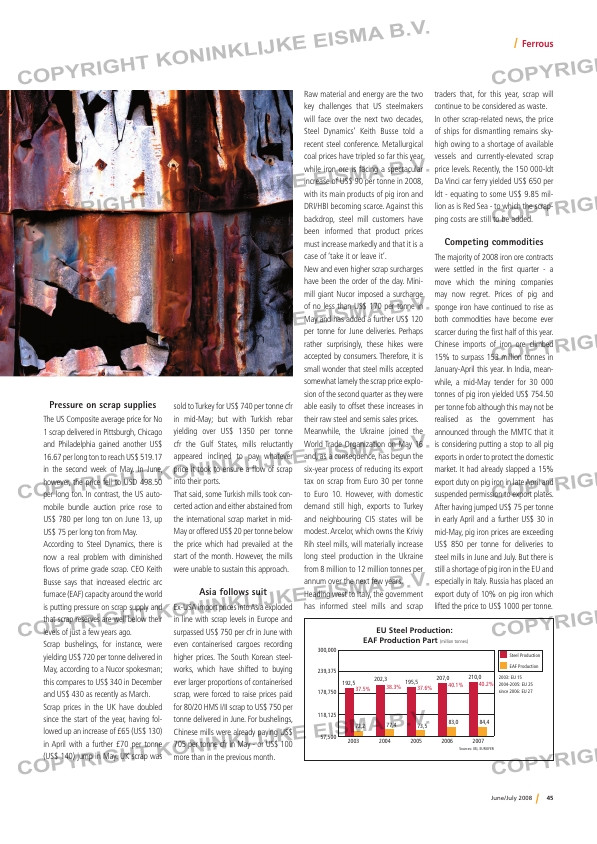Page 45 from: June / July 2008

45June/July 2008
Ferrous
Pressure on scrap supplies
The US Composite average price for No
1 scrap delivered in Pittsburgh, Chicago
and Philadelphia gained another US$
16.67 per long ton to reach US$ 519.17
in the second week of May. In June,
however, the price fell to USD 498.50
per long ton. In contrast, the US auto-
mobile bundle auction price rose to
US$ 780 per long ton on June 13, up
US$ 75 per long ton from May.
According to Steel Dynamics, there is
now a real problem with diminished
flows of prime grade scrap. CEO Keith
Busse says that increased electric arc
furnace (EAF) capacity around the world
is putting pressure on scrap supply and
that scrap reserves are well below their
levels of just a few years ago.
Scrap bushelings, for instance, were
yielding US$ 720 per tonne delivered in
May, according to a Nucor spokesman;
this compares to US$ 340 in December
and US$ 430 as recently as March.
Scrap prices in the UK have doubled
since the start of the year, having fol-
lowed up an increase of £65 (US$ 130)
in April with a further £70 per tonne
(US$ 140) jump in May. UK scrap was
Raw material and energy are the two
key challenges that US steelmakers
will face over the next two decades,
Steel Dynamics’ Keith Busse told a
recent steel conference. Metallurgical
coal prices have tripled so far this year
while iron ore is facing a spectacular
increase of US$ 90 per tonne in 2008,
with its main products of pig iron and
DRI/HBI becoming scarce. Against this
backdrop, steel mill customers have
been informed that product prices
must increase markedly and that it is a
case of ‘take it or leave it’.
New and even higher scrap surcharges
have been the order of the day. Mini-
mill giant Nucor imposed a surcharge
of no less than US$ 170 per tonne in
May and has added a further US$ 120
per tonne for June deliveries. Perhaps
rather surprisingly, these hikes were
accepted by consumers. Therefore, it is
small wonder that steel mills accepted
somewhat lamely the scrap price explo-
sion of the second quarter as they were
able easily to offset these increases in
their raw steel and semis sales prices.
Meanwhile, the Ukraine joined the
World Trade Organization on May 16
and, as a consequence, has begun the
six-year process of reducing its export
tax on scrap from Euro 30 per tonne
to Euro 10. However, with domestic
demand still high, exports to Turkey
and neighbouring CIS states will be
modest. Arcelor, which owns the Kriviy
Rih steel mills, will materially increase
long steel production in the Ukraine
from 8 million to 12 million tonnes per
annum over the next few years.
Heading west to Italy, the government
has informed steel mills and scrap
traders that, for this year, scrap will
continue to be considered as waste.
In other scrap-related news, the price
of ships for dismantling remains sky-
high owing to a shortage of available
vessels and currently-elevated scrap
price levels. Recently, the 150 000-ldt
Da Vinci car ferry yielded US$ 650 per
ldt – equating to some US$ 9.85 mil-
lion as is Red Sea – to which the scrap-
ping costs are still to be added.
Competing commodities
The majority of 2008 iron ore contracts
were settled in the first quarter – a
move which the mining companies
may now regret. Prices of pig and
sponge iron have continued to rise as
both commodities have become ever
scarcer during the first half of this year.
Chinese imports of iron ore climbed
15% to surpass 153 million tonnes in
January-April this year. In India, mean-
while, a mid-May tender for 30 000
tonnes of pig iron yielded US$ 754.50
per tonne fob although this may not be
realised as the government has
announced through the MMTC that it
is considering putting a stop to all pig
exports in order to protect the domestic
market. It had already slapped a 15%
export duty on pig iron in late April and
suspended permission to export plates.
After having jumped US$ 75 per tonne
in early April and a further US$ 30 in
mid-May, pig iron prices are exceeding
US$ 850 per tonne for deliveries to
steel mills in June and July. But there is
still a shortage of pig iron in the EU and
especially in Italy. Russia has placed an
export duty of 10% on pig iron which
lifted the price to US$ 1000 per tonne.
sold to Turkey for US$ 740 per tonne cfr
in mid-May; but with Turkish rebar
yielding over US$ 1350 per tonne
cfr the Gulf States, mills reluctantly
appeared inclined to pay whatever
price it took to ensure a flow of scrap
into their ports.
That said, some Turkish mills took con-
certed action and either abstained from
the international scrap market in mid-
May or offered US$ 20 per tonne below
the price which had prevailed at the
start of the month. However, the mills
were unable to sustain this approach.
Asia follows suit
Ex-USA import prices into Asia exploded
in line with scrap levels in Europe and
surpassed US$ 750 per cfr in June with
even containerised cargoes recording
higher prices. The South Korean steel-
works, which have shifted to buying
ever larger proportions of containerised
scrap, were forced to raise prices paid
for 80/20 HMS I/II scrap to US$ 750 per
tonne delivered in June. For bushelings,
Chinese mills were already paying US$
705 per tonne cfr in May – or US$ 100
more than in the previous month.
EU Steel Production:
EAF Production Part (million tonnes)
57,500
118,125
178,750
239,375
300,000
2003 2004 2005 2006 2007
84,483,073,577,472,2
210,0207,0
195,5202,3192,5
37.5% 38.3% 37.6%
40.1% 40.2%
2003: EU 15
2004-2005: EU 25
since 2006: EU 27
Steel Production
EAF Production
Sources: IISI, EUROFER
RI_037 MA-Ferrous.indd 45 19-06-2008 14:57:56



